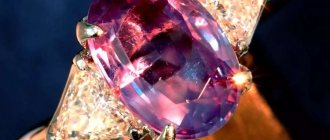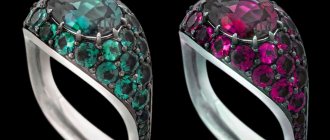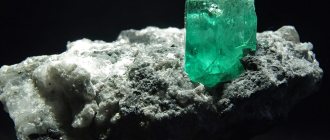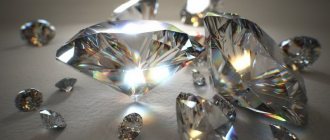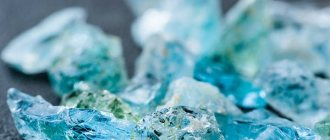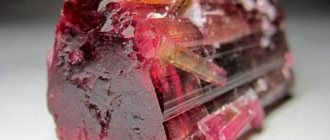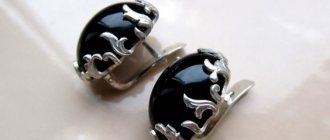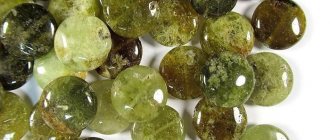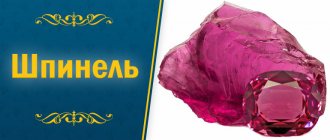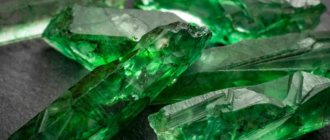Alexandrite is still a very young gemstone, because it was discovered only in the nineteenth century.
Natural stone is a rare mineral and is therefore highly valued all over the world, resulting in a cost of tens of thousands of dollars. A special feature of this stone is its ability to change its color depending on the lighting - pleochroism - from emerald green to bright red. The purer the color produced, the more expensive the alexandrite.
Ural stone is widely used in the production of jewelry that amazes with its beauty and grace. It also finds application in science - quantum mechanics, medicine, cosmetology (synthetic analogues).
History of the Ural gem
Alexandrite was discovered in the Urals in 1934 on the sixteenth birthday of Emperor Alexander II by Finnish geologist N. Nordenschild. Since this was the year the Tsar came of age, the stone was named after him and was presented to the birthday boy by jewelry craftsman Perovsky.
But the first mention of the Peacock Eye nugget was found in the four-thousand-year-old Indian treatise “Mahabharata”.
The mineral was especially popular among noble society in the nineteenth century and was worth fabulous money.
In Russia, since 1980, they began to grow and create artificial synthetic minerals - fakes of natural stone, the cost of which was several times cheaper.
Currently, the bulk of production comes from large fields located in Brazil, Tanzania, Sri Lanka, Africa and Russia (Malyshevskoye field). Ural alexandrites are the most valuable minerals, as they have a bright color and a contrasting transition from one to another.
Types of Alexandrites
In nature you can find the following types of this mineral:
- Tsimofan, popularly called a cat's eye. It is found very rarely. The light effect of this variety is obtained due to the fact that a large number of small inclusions in the mineral are oriented in the same direction. Therefore, under certain lighting conditions, a bright stripe appears in the middle part of the stone, similar to a cat’s eye.
- Ural Alexandrite is the most valuable stone, the color of which changes from green to red.
- In the deposits of India, a variety is mined that changes color from yellow to pink.
How to distinguish synthetic alexandrite from natural one
The differences between synthetic and natural alexandrite are noticeable under a microscope. Gemologists focus on the number and nature of inclusions. The easiest to recognize are stones synthesized by the Czochralski method - they are very pure. In addition, synthetic alexandrites exhibit stronger reversal and fluoresce red in ultraviolet.
Cat's eye stones produce a faint fluorescence - orange-red on the inside, and pale yellow on the surface. They are also distinguished using a microscope. Synthetic alexandrites are dominated by fine silty particles, while natural ones are dominated by tubular and needle-shaped inclusions.
Chemical composition of the Ural gem
The mineral contains mainly chromium (giving green), titanium and iron (red elements). It is the properties of chromium ions and the crystal lattice that cause the stone to change color. Vanadium, which can also influence the transformation of alexandrite, is rarely found among inclusions.
Ural natural stone has the formula BeAI2O4, which is due to the chemical composition of complex beryllium and aluminum tetroxide, and is a type of the mineral chrysoberyl.
Another feature of this mineral is its hardness, which is higher than that of emerald. It is eight and a half units according to the Moss scale.
The density of alexandrite is determined by the plug 3.5-3.8 g/cm3, and the refraction is 1.74-1.76.
Medicinal properties
Traditional healers say that it is worth paying attention to the healing properties of alexandrite:
- stops bleeding;
- it is used to clean the blood;
- used in the treatment of blood vessels and heart;
- has a positive effect on the functioning of the spleen and liver;
- helps with diseases of the pancreas;
- treats alcoholism;
- copes with neurological disorders.
Traditional medicine advises wearing jewelry made using this stone for healing, for example, a ring with Ural alexandrite.
Magic endows this mineral with the ability to enhance the qualities inherent in a particular person: it subjugates the weak under its power and can destroy, and supports the strong and helps to overcome problems.
It is also believed that this gem has different properties depending on the time of day: in the evening it enhances feelings of jealousy and passion, during the day - confidence and calmness.
And since the assassination of the Russian emperor, a tradition arose in Rus' of widows wearing this stone as evidence of the loss of a loved one.
In India, the nugget is considered a symbol of peace and is worn by priests.
Why is it called widow's stone?
Many people are interested in why alexandrite is called the widow's stone. This concept is used exclusively in the post-Soviet space. In the twenties, a synthetic variety of the gem began to be produced here. As a result, the stone has become very popular among women.
After the end of the Great Patriotic War, many women lost their husbands and became widows. As a result, prejudices have linked alexandrite and widowhood. Moreover, in those days, most people did not understand where the stone was natural and where it was artificial. Nevertheless, prejudice is firmly ingrained in our heads. So it came to be that alexandrite is a widow’s stone.
Stone price
A natural gem has a very high cost, which depends on its color, jewelry processing, and the presence of defects. As a rule, it is rarely used independently in products; it is complemented by pearls, rubies, emeralds and diamonds. Alexandrite is in the top five in terms of price, along with such expensive minerals as sapphire, diamond, ruby and emerald.
The frame for gemstone products is most often made of gold, but silver is also used for these purposes.
Alexandrite can be purchased at a price of five hundred dollars (artificial), and natural Ural - from five thousand. The maximum value is twenty thousand dollars per carat.
The factors that determine the price are the following:
- color saturation of the mineral regardless of the time of day;
- presence of inclusions and cloudiness.
Mid-level buyers can purchase synthetic stones that look completely indistinguishable from the original. In Russia, they produce an analogue of alexandrite, which has a lilac color similar to amethyst.
Malyshevsky underground mine
For the first time in Russia, emeralds were found in December 1830 by the peasant of the Beloyarsk volost, Maxim Stepanovich Kozhevnikov, on the Tokova River. This unique find gave impetus to the search for emeralds in the vicinity of the Sretensky mine.
Thus, in 1833, to the north of the Sretensky mine, the peasants Korelin and Golendukhin discovered the Mariinskoye (Maryinskoye) deposit. Development of the field began at the beginning of 1834 from the Department of Estates, and later was also carried out by the Cabinet of His Imperial Majesty. In the first year, a large amount of valuable raw materials of high cost was found. The Mariinsky mine was the northernmost and was located on the border of four forest blocks of the former Monetnaya Dacha: 216, 217, 240 and 241. At the time of Grevingkom’s visit in 1853, the Mariinsky mine consisted of 14 numbered (No. 28-36, No. 41-44) and 11 experimental pits. The pits were laid in the most elevated places, where the shale almost reached the surface of the earth, thereby avoiding the accumulation of water in the pits.
Old allotment and ditch at the Mariinsky (Maryinsky) mine.
For a long time, the Mariinsky mine was considered the best, both in terms of wealth and quality of emeralds. Not only dark emeralds were mined here, but also the best wine-yellow and pink phenacites, found in separate nests. Large crystals of rutile were also found. Mine No. 31 was especially rich in stones. The Mariinsky mine was first excavated by Miklashevsky in 1860-1861; he found “5 strips of emerald-bearing shale among the diorite rock.”
Geological map of the Mariinsky mine.
In 1903, the Mariinsky mine began to be developed by Novaya Gazeta. Three shallow mines were laid at the mine, two of which were soon stopped: the first due to the lack of emeralds, the second due to a strong water influx. The third mine remained in development for some time. The mines had drifts in the direction of the shale veins. Since the rocks encountered were very soft, it was rarely necessary to resort to blasting, but the workings required continuous fastening. The slate was carefully broken out with a pick and raised to the surface in buckets. The mica veins were completely mined out. If an emerald was found in the face, then the senior overseer or foreman took it out separately and put it in a sealed mug. On the surface, the rock was sorted by size and larger pieces were sent for disassembly, while smaller pieces immediately went into washing. The dismantling of the stones was carried out by boys who carefully broke pieces of slate with a hammer, discarding the valuable stones they came across into sealed mugs. The fines were washed on iron screens, where they were moved under running water with wooden shovels. Stones found during washing were also placed in sealed mugs. In 1904, they tried to use open work in soil-bench cuts. To reduce the cost of drainage, work was carried out in winter. All mined shale was taken to the Troitsky mine for washing. In 1907, underground work was resumed, for which three more shafts were sunk up to 6 fathoms deep. The following year, these mines were stopped and open-pit mining began again in two new locations. In 1910, Novaya began to explore areas away from the open-pit mines, but without receiving favorable results, work at the mine was finally stopped. During the development of the Novaya mine, 129,147 pounds of emerald shale were mined. At the beginning of the revolution, the company finally abandoned work, and the Mariinsky mine is rented by V.I. Lipin is the owner of stone-cutting workshops from the city of Yekaterinburg. However, already in the summer of 1917, Lipin was expelled from the mine by the “hitniks”, who declared themselves the absolute masters of the Emerald Mines. In 1919, the Mariinsky mine was nationalized. But the state did not have enough funds to develop the mine, and therefore the explored deposits were divided into sections and transferred to miners. Prospectors worked in groups of 20 people (to a depth of 10-14 m), who partly cleared old French mines with quite a large amount of emerald rock. After the revolution, the entire area of the deposit was covered with a network of pits. The Staro-Mariinsky site was occupied by old prison mines, where the labor of criminals was used in the 1860s. To the east of the Mariinsky mine there were the Krestovik and Pokosy sites. The Krestovik mines were famous for their dense green stones, and the site was distinguished by extraordinary tectonic disturbance, there were no real pegmatite veins, and there were only isolated nodules - lenses of feldspar in a metamorphic suite, bordered by biotite rims.
In 1924, at the northernmost, Staro-Mariinsky mine, several artels worked on mines and two open cuts for the extraction of fluorspar (very pure, light purple in color). A separate huge arc-shaped vein of fluorspar with rims of diphapite (Margarita) was developed. In July of the same year, in the plot of the prospector Skutin, the southernmost of the Staro-Mariinsky mines, in the northern part of the Central Formation of the deposit, a nest of about a cubic meter in volume was discovered, containing high-grade emerald crystals. Cutting raw materials worth half a million gold rubles were obtained from the rock mined here - stones of the highest class, thick, even green tone and rare purity. In 1927, the southern section of the Mariinsky mine began to be explored by the Russian Gems trust, since it was considered the most reliable, and the rest of the mines were spoiled by previous work. Exploration did not produce positive results and from the following 1928 all geological exploration work was transferred to the Geological Committee. In September 1927, the mines of the Ural emerald mines were renamed. Nizhne-Mariinsky, Staro-Mariinsky and Novo-Mariinsky areas were merged into the mine named after. THEM. Malysheva (Malyshevsky mine).
For a detailed exploration of the Malyshevsky mine, the consultant of the Mineralrud trust, Freiberg professor A. Ohnesorge, proposed removing a 20 m thick layer from the entire mine area with excavators. But this idea was abandoned for objective reasons. A significant event in the history of the mines was the laying of three mines in the central part of the Malyshevskoye deposit in 1929 - “Imeni Stalin”, “Imeni Kirov” and “Novaya” with a depth of up to 75 meters. At the same time, the construction of the Malysheva workers' village and the processing plant was underway.
In 1930, exploration and production work established that the Malyshevskoye deposit was not only a source of emeralds, but also promising for industrial beryl. In connection with the development of the domestic beryllium industry, the Emerald Mines are becoming important as a raw material base for beryllium. For this reason, on August 29, 1931, the mines were transferred from Mineralrud to the Soyuzredmet association, and on September 1, 1931, the emerald workshop of the Sverdlovsk lapidary factory was transferred. In 1939, due to difficulties in selling emeralds, mining operations began to be curtailed and in 1939-1940 underground exploitation at some emerald deposits proper ceased. By government order, in August 1941, the Malyshevsky mine was put into dry conservation.
In 1950, a decision was made to open-pit mine the Malyshevskoye deposit, and in the same year stripping work began, which was fully completed in 1957. The quarry was founded on the site of an old French mine, and during its development they often came across ancient underground workings.
View of the Malyshevsky quarry.
Fully mechanized mining work was carried out from 1956 to 1971 to the design level of the quarry bottom - 125 m. The length of the quarry on the surface is 1400 m, the average width is 300 m. The general angle of offset for the western side is 42°, for the eastern side - 39°. The opening of the deposit was carried out by digging a capital exit trench laid from the northern side of the quarry and passing along its eastern side (more stable) with a slope of 8°. Transportation of the rock mass was carried out by dump trucks with a carrying capacity of 25 tons. The development of the deposit was carried out by a system of parallel transverse stopes. The height of the working bench was 5 m. Over twenty years of operation, 4,559,000 tons of marketable ore were mined in the quarry.
Malyshevsky mine quarry. The surface complex of the Kapitalnaya mine is visible in the background.
All waste rocks (various shales, quartzites, amphibolites, serpentinites, diorites) were stored in a dump of substandard ores. Over the entire period of operation of the quarry, 6,609 thousand tons of substandard ore were mined. Substandard ore due to its low beryllium oxide content (0.020%) and extremely high dilution (93%) is currently unsuitable for processing at a beryllium concentration plant in order to obtain standard (5%) flotation beryllium concentrate. In 1965, simultaneously with the open-pit mining method, construction of an underground mine began at the Malyshevskoye deposit.
To open the deep part of the Malyshevskoye deposit, three mines were drilled: Severnaya, Kapitalnaya and Yugo-Vostochnaya. The design depth of development of the deposit is assumed to be 360 m (horizon -120 m). The shaft of the Yugo-Vostochnaya mine with a diameter of 6 m has a circular cross-section, is fixed with concrete and goes to a depth of 367 m. The shaft is equipped with a two-story cage with a capacity of 32 people and is designed for lowering people, materials and equipment. Also, the shaft of the Yugo-Vostochnaya mine serves to supply fresh air to the mine workings.
Ore yard of the Yugo-Vostochnaya mine on the mountain. -30 m.
The Kapitalnaya mine shaft is driven to a depth of 376 m and is used to release ore and waste stream. The Severnaya mine was driven to a depth of 231 m. Until the 1980s, it was the main shaft and exploitation and exploration were carried out through it; at the moment it serves for ventilation. The Malyshevsky mine has 6 working horizons: +90, +60 m, +15, -30 m, -75 m, -120 m (150, 180, 225, 270, 315 and 360 m from the surface, respectively).
The development of horizons +90 m, +60 m and +15 m was carried out in 1972-1982; by 1990, work had descended to horizons -30 m and -75 m.
Old spent orts.
Unused outlet hatch with vibrating feeder.
Rock outcrops in the waste ort.
Currently, mining is carried out at a depth of 260-300 m from the surface of the earth and in the future mining operations will decrease. There is a crosscut in the mine, and in the hanging and lying sides there are field drifts - eastern and western. Capital excavations are secured with metal arched support made of special profile SVP-22 with reinforced concrete tightening. In hard rocks, fastening is done with reinforced concrete or metal rods and shotcrete.
Western field drift.
The field drifts are laid 5-10 m from the contour of the ore deposit in such a way as to exclude their undermining during mining operations on the underlying horizon.
Every 40 m, the field drifts are driven down by ores, passing across the strike of the ore deposit. From the orts, ore drains and ventilation and stowage risers pass through. The rebels are knocked down by layered orts, from which cleaning work is then carried out.
The rebels have three departments - running, material and ore passing.
The running and material compartments are secured with a continuous crown of wooden support, and the ore chute - with metal pipes with a diameter of 1220 mm. On the underlying horizon, under the ore dispensing compartments, vibratory feeders are installed for loading trolleys. During the mining operations, a mining system was adopted in slightly inclined descending layers from top to bottom with a height of 2.5-3 m with filling of the mined-out space with hardening mixtures. The height of the treatment layer depends on the stability of the host rocks at their contacts with the ore zones and is determined by the layer mining scheme.
The clearing excavation in the block begins only after the preparatory and cutting excavations necessary to begin clearing and backfilling work, the implementation of ventilation and dust control measures and other measures to ensure the safety of work.
Excavation stops are located on both sides of the layered ort and run obliquely at an angle of 3-8° to increase the completeness of the backfill. The cross-section of the stopes, depending on the thickness of the ore veins and the delivery equipment used, ranges from 4.5 to 36 m² under the fill and from 3.6 to 11 m² in the pillar.
Breaking of emerald-containing ore is carried out using a special technology that ensures maximum safety of emerald crystals, including the drilling and blasting method (using low-blasting substances such as “Uglenit” and “Ionite”), the use of machines with a hydrowedge and impact wedge mechanism, and in areas of high concentration - using hand tools (picks, crowbars and wedges).
Prepared face for mounting a scraper in a layer ore.To secure the workings, frame support, racks for purlins and suspended metal support with safety posts are used.
Delivery of timber to waste treatment pits.
Wooden support is cut using pneumatic chain saws.
For comfortable work in the mine there are dry closets.
The ore is represented by emerald-bearing mica (phlogopite) and beryllium-bearing quartz-plagioclase veins, contained among talc and talc-tremolite schists. Ore dilution during mining is about 50%, losses - 7%.
The broken rock mass is consolidated onto a layered ore, along the layered ore it is consolidated into the ore discharge department, where it is loaded into blind trolleys with a capacity of 1.2 m³ through a vibrating feeder and rolled back to the ore yard of the Kapitalnaya mine.
Layer orth.
Scraper winch in a layered ort.
7KRM1 mine contact electric locomotives are used for haulage.
Southern and Northern entrances to the Kapitalnaya mine.
Ore yard of the Kapitalnaya mine.
Trolleys loaded with ore are rolled into a two-story cage and brought to the surface.
On the surface, the trolleys undergo radiometric sorting and are sent to ore or rock bunkers. Waste rocks and off-balance ores are used for reclamation of a spent quarry, and the ore is delivered to an emerald extraction plant, where it undergoes multi-stage processing. The ore is crushed and after additional washing, the classified material is supplied to a conveyor belt, where emeralds are manually selected. Pieces of ore larger than 20 mm, after manual sampling, are sent to a photoneutron separation unit, which makes it possible to additionally extract emerald and beryl crystals hidden in the nodules. After completion of the clearing work, the mined out blocks are filled with backfill mixture.
The workings are cleaned, drained and given the necessary slopes. To isolate the workings, jumpers are installed, after which a backfill pipeline is laid.
The soil and sides of excavations are reinforced with metal mesh, the space of layered orts and stopes is reinforced with elements of suspended reinforcement (hooks and loops).
Backfill material is prepared on the surface from local materials (ash and tailings) and Portland cement grade 400, after which the pulp is fed by gravity through wells and pipes into the treatment workings. The first thing to do is clearing work, then the layer ort.
The layered development system with backfill was introduced in 1972; the introduction of this system was a truly revolutionary event in the history of the Emerald Mines. Such a system allows one to avoid movements of the earth’s surface, ensures a high degree of work safety, and makes it possible to develop the deposit with minimal losses of raw materials. After the implementation of the backfill system, the Malyshevsky mine turned into an exemplary enterprise for the extraction of emerald, which has no analogues among the existing mine workings of the same purpose in the world. If you visually imagine the volume of the enclosed space, then the dimensions of this monolithic reinforced concrete structure will be 600-900 m in length and 50-150 m in width. The total weight of the monolithic structure by 1991 was 4 million tons with a volume of 2 million m². The system of mining the deposit, the methods of selecting emerald-containing ore and its processing give a high result in the preservation and extraction of crystalline raw materials.
Since 1987, the enterprise was completely focused on the extraction of emerald-bearing mica ores, which were processed at the emerald extraction factory. Until 1993, the Malyshevskoye Mining Administration (MRU) was the subsoil user of the deposit, and then JSC Emerald Mines of the Urals (JSC IKU) and JSC Malyshevskoye Mining Administration were separated. OJSC “Emerald Mines of the Urals” carried out underground mining of emeralds until the end of 1995. The annual production of emeralds did not exceed 300 kg. Since 1995, the Malyshevsky mine was on the verge of closure and flooding. In 2001, the Russian-Irish enterprise ZAO Zelen Kamen was created; They did not develop the deposit, but processed industrial products from previous years. In 2004, a new investor was attracted to the enterprise - Tsar Emerald Corporation (Canada). Only in October 2005 did it begin active restoration of the Malyshevsky mine. Thanks to the support of the government of the Sverdlovsk region, repair and restoration work began at the mine. By 2006, the following were repaired: the lifting complex and the main ventilation fan of the Yugo-Vostochnaya mine, a major overhaul of the headframe, stowing complex, and drainage installations of the Kapitalnaya mine was completed. A major overhaul of the mine lift buildings, mechanical repair shops, substations, garage, and material warehouse was carried out. All this made it possible to restore the mine and resume emerald mining.
In 2008, the Ministry of Natural Resources of the Russian Federation revoked the license of Zelen Kamen CJSC for violations of subsoil use conditions. Since 2008, the Kaliningrad Amber Plant (“KYAK”), on the basis of short-term licenses, has carried out repair and restoration work at the Malyshevsky mine and maintained it in working order. In June 2011, the State Unitary Enterprise "KYAK" received a license for the use of subsoil with a validity period until June 2031. Since December 2011, the Plant, through the Malyshev Separate Division, has resumed mining, and since March 2012, ore processing at the emerald extraction factory. Over the entire period of operation, as of the beginning of 2016, the Malysheva OP enterprise produced 184,080 thousand tons of marketable ore, and processed 153,310 thousand tons. The development period of the Malyshevskoye deposit is 57-76 years.
The Malyshevskoye emerald-beryllium deposit is currently the only emerald mining site in Russia, one of three in the world and the largest in the Emerald Mines in terms of reserves of ore, emeralds and beryllium. According to the drilling of a deep prospecting and structural well, completed in 1991, the ore zone in the southern part of the deposit extends to a depth of 1100 m from the surface without signs of pinching out. The ore zone is divided into three main vein formations: Western, Central and Krestovskaya, confined to the fault zones of the same name. The Central Formation is the most saturated with ore bodies and is the largest in terms of reserves of beryllium ore (67%) and emeralds (91%). The Western suite is important only as a source of beryllium raw materials, and the Krestovskaya suite currently has no practical significance (2% of ore) and is not involved in mining production. The ore zone of the Malyshevskoye deposit is traced from north to south for 1100 m, with a surface width of 250 m. In the central part of the deposit, mineralization is traced to 490 m without signs of pinching out. The main reserves of beryllium ores and emeralds are confined to the northern and central sections of the deposit (85% and 94%, respectively). In the Northern area there is the Main Ore Column, which has a thickness of 40-80 m and is traced along the strike for 160 m. The column has a pipe-like shape, a steep eastern dip (75-80°) and a southern declination (75°). It is confined to the fault junction area. The ores of the pillar are distinguished by the highest contents of Be and emeralds. In 1996, the ore column was mined to a depth of 270 m from the surface, and throughout its entire length there were no noticeable changes in the main indicators. In the central part of the deposit, at a depth of 130-140 m, another ore column is distinguished, which has a more complex shape.
Despite the uneven distribution of ore bodies in the horizontal sections of the “vein” formations, with depth the overall saturation of the formations with ore bodies remains unchanged and their average thickness does not change, and the reserves of beryllium ores and emeralds even increase. Dimensions of the veins: length 30-50 m, thickness 0.2-3.5 m. The main useful components of the deposit are emerald and beryllium oxide, associated - chrysoberyl, phenacite, alexandrite, phlogopite, lithium, rubidium, cesium. Beryllium ore has low BeO content, and, therefore, beryl can only be mined as a by-product.
Ural emeralds are highly valued on the world market for precious stones, as they are endowed with a unique yellowish tint, not characteristic of this mineral, and are known under the brand “Malyshevsky emeralds”. Between 1976 and 1990, many large emeralds weighing from 3,000 to 32,750 carats were mined at the Malyshevskoye deposit. The most famous emeralds: “Glorious Ural” (3370 carats), “New Year” (6900 carats), “60 years of the Soviet Army” (7000 carats), “President” (5860 carats), “Zvezdar” (4150 carats) and an intergrowth of 6 “Miner’s Glory” crystals (32,750 carats). The “Miner’s Glory” emerald was mined by miner P.P. Bebenov in November 1989 along the famous Vostochnaya vein.
Emerald from the collection of the Ural Geological Museum of the Ural State Mining University. Photographer: Evgeny Sakulin.
The largest emerald crystal, “Commercial”, weighing 12,900 carats, was extracted in 1982. As for other stones, one of the largest phenacites was mined at the Malyshevskoye deposit in February 1991. Its dimensions are 7x12x13 cm. On December 22, 1981, at a horizon of +55 m, an intergrowth of alexandrite crystals weighing 446 grams was mined with inclusions of single crystals and intergrowths of various combinations of alexandrites with a total mass of gem-quality stones of 288 carats.
Emerald from the collection of the Ural Geological Museum of the Ural State Mining University. Photographer: Evgeny Sakulin.
In 1984, an amazingly beautiful small druse of alexandrite crystals in the amount of 20 pieces in mica was mined at the Malyshevsky underground mine. In 1992, an alexandrite crystal weighing 176 g was mined, perfect in color, quality, crystallographic cut and alexandrite effect. In August 2012, the largest emerald in a decade weighing 637 grams was mined; it received its own name “Yubileiny”, in honor of the 65th anniversary of the Amber Plant. In December 2016, the mine produced beryl weighing 5.5 kg and a first-class emerald weighing 230 g.
I express my gratitude and appreciation to the management of the OP “Malysheva” in the person of director Vasilevsky E.M. for organizing and conducting a tour of the enterprise, the geologist of the Malysheva mine M. Titov for accompanying him around the mine, as well as the director of the Ural Geological Museum D.A. Kleimenov. and the director of the Ural Stone Center F.M. Nurmukhametov. for assistance and assistance.
Used literature and sources:
Albrecht V.G., Popov M.P., Leikum M.S., Reus P.A. The mysterious stone of Tsar Alexander (about alexandrite, Alexander II and not only about them). 2016, 2nd edition. Boldyrev A.A. Concentrating factories of the Emerald Mines of Glavredmet. // “Non-ferrous metals”, No. 4-5. "Mining Journal". 1854. Grevingk K. Ural emerald mines and their surroundings. 1854. Zolotukhin F.F. Mariinskoye (Malyshevskoye) emerald deposit, Middle Urals, Asbest. 1996. Zolotukhin F.F., Samsonov A.V. Ural emerald mines. // “News of higher educational institutions. Mining magazine". No. 7-8. Korolev O.E. Malyshevskoye Mining Administration. Mining and processing of emerald ore. // “News of higher educational institutions. Mining magazine". 1993, no. 11. Leviatov G.O. Emerald deposit in Monetnaya Dacha. // "Mineral raw materials". 1929, no. 9. Popov M.P. Geological and mineralogical features of rare metal mineralization in the eastern exocontact of the Adui massif within the Ural emerald belt. 2014. Excursion guide. XI All-Russian Petrographic Meeting. Semenov V.B. History of the development of emerald deposits. // "Ural Geological Journal". 2002, No. 2 (26). Uspensky N.M. Deposit of emeralds at a coin cottage in the Urals. 1. General outline. Proceedings of TsNIGRI. Vol. 116, 1939. Fersman A.E. Precious and colored stones of Russia. vol. II, 1925. Fersman A.E. Selected works. t. 7, 1962. https://www.ambercombine.ru/about_us/op_quot_malyshev_quot/.
Malyshevsky underground mine on the map:
How to recognize an analogue
A distinctive feature of nuggets is the change in color with changes in illumination, which is caused by the presence of three optical axes in the nugget. Interestingly, under fluorescent lamps this effect is practically invisible.
The only mineral that is similar in appearance to Ural alexandrite is green andalusite. But it is just as rare as the original.
More often, as a replacement for gems, synthetically grown analogs are used - spinel and corundum, which are similar to the original in chemical composition. They can be distinguished by their color - unlike a nugget, they shimmer from blue-gray to pink and are much more intense.
The main candidates for replacing alexandrite are artificial chrysoberyl, phenacite, cubic zirconia, inamori, garnet, andalusite, and spinel. When buying jewelry, you need to check whether there is a gemological examination certificate.
Despite all the instructions, it is quite difficult, if not impossible, for an ordinary person to distinguish the original from the analogue on their own. The best option would be to contact a jewelry specialist - using special instruments (spectroscope and refractometer) he will determine the origin of the mineral.
Who does the stone suit according to their zodiac sign?
Many people are interested in who is suitable for alexandrite. It is best to wear the gem for Gemini, Aries and Scorpio horoscopes. Representatives of these constellations have a strong character and are able to tame a gem. At the same time, it is better for Cancers, Virgos and Taurus not to use this stone. They are distinguished by a calm and reasonable character, but at the same time they are very vulnerable.
Representatives of other zodiac signs can safely wear jewelry with alexandrite if it is convenient for them. At the same time, the gem has the following effect on people:
- For Scorpios, the crystal gives strength to overcome difficult life challenges. The stone helps representatives of this sign become more courageous and purposeful.
- Sagittarius will be able to become more confident in themselves and achieve their goals.
- For Aquarius, the crystal will help enhance creativity, develop intuition and strengthen the spirit.
- Alexandrite will help Capricorns in matters of finance. However, this is only true if the person himself does not remain inactive.
- Gemini will be able to find balance with the help of the stone. At the same time, he will not suppress their interests.
- Alexandrite will bring good luck to Aries in various endeavors. In addition, it reliably protects representatives of this sign from negative influences.
- The stone will help Leos gain power. In addition, the gem promotes career advancement.
- Alexandrite brings good luck to Pisces. In addition, it helps you find your life purpose.
- For Libra, the crystal will help develop creative abilities. With the help of alexandrite, representatives of this sign can find themselves and their favorite pastime.
Jewelry suits almost all zodiac signs, but there are some exceptions.
